15 Best Telescopes in India [August, 2024]
For astronomy enthusiasts exploring the best telescopes in India to unlock views of celestial wonders, aperture size and mount type serve as primary considerations that widely vary across hundreds of available instruments. As we analyze top-rated reflector, refractor, and compound models across beginner and advanced tiers based on performance per unit value, excellent quality can be found meeting different portability needs and budget constraints.
/ IN THIS ARTICLE [ hide ]
- Celestron PowerSeeker 60AZ Telescope
- Celestron AstroMaster 70AZ Telescope
- Pie Matrix Phoenix Refractor Telescope 60700
- Celestron Speciality Series Travel Scope 70 Telescope
- Celestron AstroMaster 130 EQ Telescope
- Celestron AstroMaster 130 EQ Motor Drive Telescope (Grey)
- Celestron 21064 AstroMaster 90 EQ Refractor Telescope
- STARSENSE Explorer DX 102AZ Smartphone APP-Enabled Refractor Tele...
- Celestron PowerSeeker 70EQ Telescope (Black)
- Celestron 21035-ADS Travel Scope 70 Refractor Telescope Kit with ...
- Pie Matrix Pegasus 76mm AZ Newtonian Reflector Telescope
- Celestron PowerSeeker 127EQ Telescope
- Celestron NEXSTAR 5SE Computerized Telescope
- SSEA Telescope -Mod 70076 Reflector Astronomical Telescope- HD Pr...
- Sokkia B40A Automatic Level Without Accessories
- Comparison for best telescope in India
- FAQs about best telescope
- How to choose the best telescope in India
- Different type of telescopes
- Guide on usage, maintenance and care
- Conclusion
1. Celestron PowerSeeker 60AZ Telescope
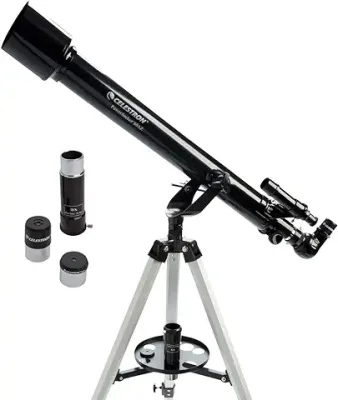
Description
The Celestron PowerSeeker 60AZ is a great option for beginners looking to get started in amateur astronomy. With a 60mm aperture, it can capture good views of the moon and bright planets. The fully-coated glass optics help deliver crisp, clear images.
Key Features
- 60mm aperture
- 700mm focal length, f/11.7 focal ratio
- Fully coated glass optics
- Alt-azimuth mount with pan handle for easy pointing
- Includes 2 eyepieces (20mm and 4mm) plus 3x Barlow lens
Our Expert Opinion
The Celestron PowerSeeker 60AZ punches above its weight given its very affordable price point. The accessories included are very useful for magnifying views. The manual alt-azimuth mount is smooth and accurate. Overall, it’s a great starter telescope to dip your toes into the starry skies above!
2. Celestron AstroMaster 70AZ Telescope
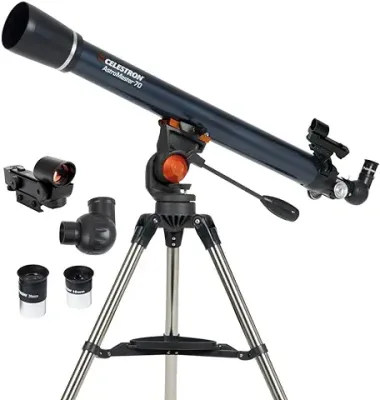
Description
The Celestron AstroMaster 70AZ is a great option for hobbyists looking to upgrade from their first beginner telescope. With a 70mm aperture, views of the planets and moon will be brighter and more detailed compared to smaller models.
Key Features
- 70mm aperture
- 900mm focal length, f/12.9 focal ratio
- Fully coated glass optics
- Smooth alt-azimuth mount with clutch
- Two eyepieces (20mm and 10mm) plus 3x Barlow lens
Our Expert Opinion
The AstroMaster 70AZ builds on the PowerSeeker line with a larger aperture for better light grasp. The accessories provide nice magnification options. Smooth motions in altitude and azimuth make pointing easy. Overall, it’s a great mid-sized manual telescope for detailed lunar and planetary views.
3. Pie Matrix Phoenix Refractor Telescope 60700
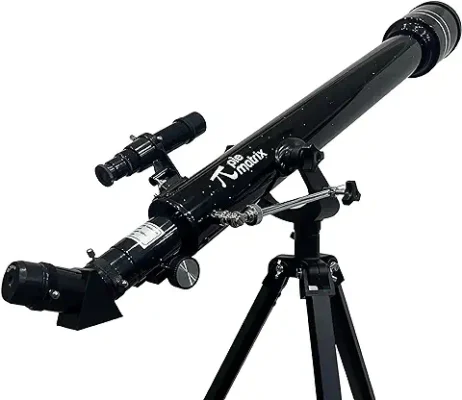
Description
The Pie Matrix Phoenix Refractor Telescope 60700 is an excellent portable telescope perfect for terrestrial and celestial viewing. It has a stylish and compact design along with high-quality optics to deliver amazing images.
Key Features
- 60mm aperture and 700mm focal length
- Fully multi-coated optical glass components
- Brass rack and pinion focuser
- Aluminium alloy tripod with accessory tray
- Comes with two eyepieces (H20mm and H5mm)
Our Expert Opinion
The Pie Matrix Phoenix checks all the boxes of what you’d want in an affordable yet powerful refractor telescope. It punches well above its price point with premium optics and smooth motions for easy pointing and tracking. Both Earth-bound and celestial targets will shine through beautifully.
4. Celestron Speciality Series Travel Scope 70 Telescope
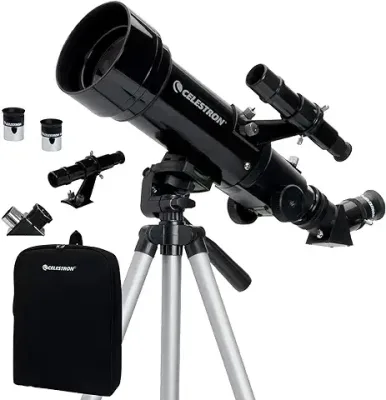
Description
The Celestron Travel Scope 70 is designed specifically for portability while delivering great optics. Its 70mm aperture strikes a nice balance for light grasp versus compact form. The fully coated glass lenses ensure bright, clear images.
Key Features
- 70mm aperture with multi-coated optics
- 400mm focal length, f/5.7 focal ratio
- Compact and portable design
- Custom backpack included for transport
- Accessory kit with two eyepieces
Our Expert Opinion
For those looking for a highly portable telescope capable of rich views, the Travel Scope 70 is a wonderful grab-n-go choice. It’s easy to set up anywhere and shows impressive details of the Moon and planets. The included backpack makes transport effortless while keeping everything secure.
5. Celestron AstroMaster 130 EQ Telescope
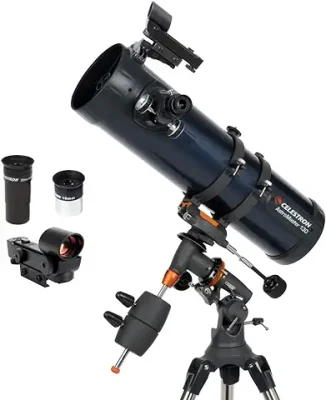
Description
The Celestron AstroMaster 130 EQ bumps up to a 130mm aperture, over twice the light grasp of 70mm models. This reveals noticeably brighter and more detailed views. The sturdy equatorial mount allows smooth tracking of celestial objects.
Key Features
- 130mm aperture with fully coated optics
- 650mm focal length, f/5 focal ratio
- Steel tripod with equatorial mount
- Includes two eyepieces (20mm and 10mm)
- Red dot finderscope and pan handle for pointing
Our Expert Opinion
The AstroMaster 130 EQ brings substantially better views over smaller telescopes in this lineup. More light means seeing finer details on the Moon and planets. The equatorial mount opens the door for basic astrophotography. It’s an excellent mid-level telescope for unlocking celestial wonders at an affordable price.
6. Celestron AstroMaster 130 EQ Motor Drive Telescope (Grey)
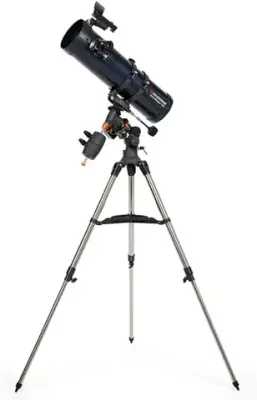
Description
The AstroMaster 130EQ with Motor Drive builds on the manual 130EQ model by adding the ability to automatically track sky objects for long exposure photography. This makes capturing galaxies, nebulae and star clusters much easier.
Key Features
- 130mm aperture with 650mm focal length
- Equatorial mount with dual axis motors
- Steel tripod, accessory tray, pan handle
- Follows objects via motors while counteracting Earth’s rotation
- Includes two eyepieces plus quick-release plate
Our Expert Opinion
Having motorized tracking on the AstroMaster 130EQ opens astrophotography possibilities at a very wallet-friendly price point. Objects can be imaged for minutes without any guiding corrections needed. Both visual and photographic capabilities make this an extremely versatile grab-n-go telescope.
7. Celestron 21064 AstroMaster 90 EQ Refractor Telescope
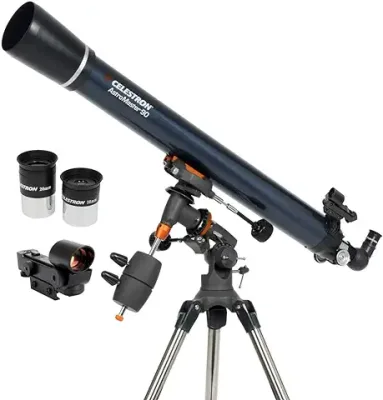
Description
The AstroMaster 90EQ refractor has many great features for both visual use and astrophotography. The 90mm aperture gathers over 40% more light than a 70mm scope, revealing brighter more detailed views. The optics produce sharp, color-corrected images across the field of view.
Key Features
- 90mm aperture with multi-coated lens
- 1000mm focal length, f/11 focal ratio
- Equatorial mount with setting circles
- Star diagonal for more comfortable viewing angle
- Includes two eyepieces (20mm and 10mm)
Our Expert Opinion
Celestron packs tremendous value into the AstroMaster 90EQ refractor given its very reasonable price. Views of the Moon and planets are brighter and more magnified compared to smaller models. The solid equatorial mount provides steady tracking for long exposure deep sky imaging. It’s arguably the best mid-sized EQ refractor telescope available.
8. STARSENSE Explorer DX 102AZ Smartphone APP-Enabled Refractor Telescope
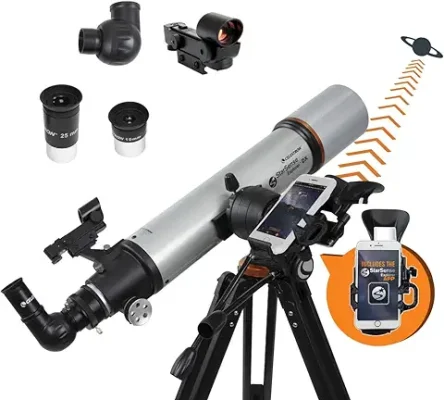
Description
The StarSense Explorer DX 102AZ brings technology to the forefront by integrating with smartphones for an interactive astronomical experience. It has a 102mm aperture to capture detailed planetary and deep sky views. The StarSense app provides guided tours of sky objects.
Key Features
- 102mm aperture with 700mm focal length
- Alt-azimuth digital tracking mount
- Integrates with StarSense Explorer app
- Guided celestial object identification
- Syncs with smartphone via Bluetooth
- Includes two eyepieces plus Barlow lens
Our Expert Opinion
The Explorer DX 102AZ is a wonderful blend of optical performance and smart technology. Having an intelligent guide in your pocket is extremely useful for learning the night sky. Views of details like Saturn’s rings and the Orion Nebula are quite impressive given its reasonable price point. It brings astronomy fully into the mobile tech era.
9. Celestron PowerSeeker 70EQ Telescope (Black)

Description
The PowerSeeker 70EQ builds optical performance on a sturdy equatorial-mounted tripod. This allows smooth manual tracking of sky objects. The 70mm aperture gathers enough light for quality views of our Moon and planets within our solar system.
Key Features
- 70mm aperture and 700mm focal length
- Fully-coated glass optical components
- Equatorial mount with slow-motion controls
- Adjustable stainless steel tripod
- Red dot viewfinder for easy pointing
- 3x Barlow lens triples magnification
Our Expert Opinion
The Celestron PowerSeeker 70EQ brings nice functionality to the table considering its very wallet-friendly price tag. Setting circles on the mount allow finding objects by celestial coordinates. Views are relatively bright and sharp. For an introductory telescope with tracking ability, it certainly packs in some great value.
10. Celestron 21035-ADS Travel Scope 70 Refractor Telescope Kit with Backpack
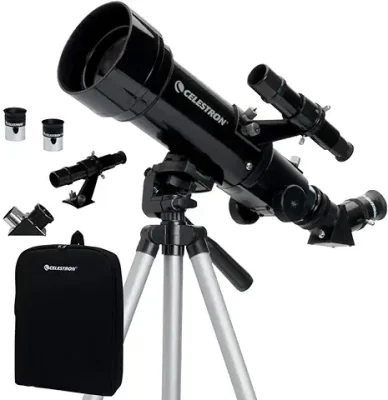
Description
The Celestron Travel Scope 70 is a portable grab-n-go telescope sold exclusively on Amazon. The 70mm refractor optical tube and accessories pack neatly into the included backpack for transportation and storage. Fully coated glass lenses deliver bright, clear views.
Key Features
- 70mm aperture refractor optical tube
- Multi-coated objective lens
- Compact design packs into custom backpack
- 400mm focal length (f/5.7)
- Smooth alt-azimuth mount with clutch
- Accessory kit includes two eyepieces
Our Expert Opinion
Having a telescope designed specifically with portability in mind makes visual astronomy much more accessible and enjoyable. The optical performance of the Travel Scope 70 punches well above its price point. Paired up with the securely protective backpack, it’s a wonderful blend of quality, value and mobility.
11. Pie Matrix Pegasus 76mm AZ Newtonian Reflector Telescope
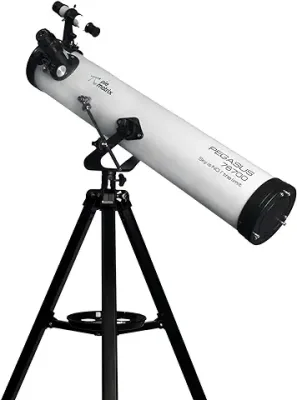
Description
The Pie Matrix Pegasus 76mm is an excellent beginner-to-intermediate Newtonian reflector telescope. Its 76mm aperture captures lots of light for beautiful views of lunar craters, planewtary details and bright deep sky objects. The different eyepiece focal lengths give nice magnification options.
Key Features
- 76mm aperture with 900 focal length
- Fully multi-coated primary and secondary optics
- Stable aluminium alloy alt-azimuth mount
- Rack-and-pinion focuser with tension adjustment
- Includes 25mm and 10mm eyepieces
Our Expert Opinion
For the price, the Pie Matrix Pegasus reflector boasts well above-average optical performance in a robust yet transportable form factor. Setting up and adjusting the mirror alignments is very straightforward. Included eyepieces provide significant magnification. Both lunar and planetary observing sessions will reward the viewer with impressively bright images.
12. Celestron PowerSeeker 127EQ Telescope

Description
The Celestron PowerSeeker 127EQ model is their largest-aperture beginner-focused telescope. With a 127mm lens light grasp, views are quite detailed and contrast-rich. The German equatorial mount allows smooth, accurate tracking of celestial objects for visual and astrophotography pursuits.
Key Features
- 127mm aperture reflector
- Fully coated primary and secondary mirrors
- 1000mm focal length (f/8 ratio)
- Equatorial mount with setting circles
- Red dot viewfinder and slow-motion controls
- Adjustable stainless steel tripod
Our Expert Opinion
There’s tremendous capability built into the PowerSeeker 127EQ considering its wallet-friendly price tag. From eye-popping lunar craters to Saturn’s rings and Jupiter’s cloud belts, views impress both visually and photographically for a mass-market telescope. It’s a great choice for unlocking cosmic detail day or night.
13. Celestron NEXSTAR 5SE Computerized Telescope
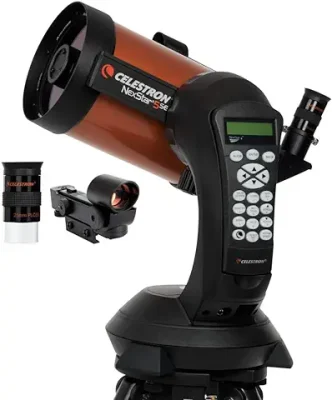
Description
The Celestron NexStar 5SE brings full computerized Go-To technology in a nicely portable package with solid optics. It has a 125mm aperture reflector lens on a motorized alt-azimuth mount. The hand controller finds 42,000+ objects and effortlessly tracks celestial targets using internal GPS.
Key Features
- 125mm aperture reflector telescope
- Fully computerized Go-To mount
- 42,000 object database with tracking
- StarBright XLT optical coatings
- Permanently programmable hand controller
- Lightweight construction, 30lbs total
Our Expert Opinion
For a mid-sized reflector, the Celestron NexStar 5SE packs tremendous capability into its computerized form factor. Optically and mechanically it performs far beyond its reasonable price point. Having automated Go-To object tracking and tours makes astronomy more fun and engaging while learning the night sky. It’s arguably the best bang-for-buck computerized telescope on the market.
14. SSEA Telescope -Mod 70076 Reflector Astronomical Telescope- HD Precise Optics –
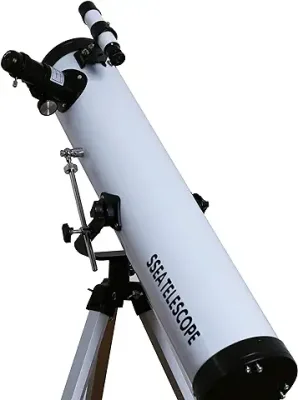
Description
The SSEA -Mod 70076 Reflector Telescope is an large-aperture Newtonian model with 7 inch (176mm) of light gathering capability. The mirror components boast precise HD optics with advanced coatings for high contrast and chromatic correction. Included eyepieces go from very low to high magnification.
Key Features
- 7-inch (176mm) primary mirror
- Parabolic secondary mirror
- Premium mirror coatings for sharp focus
- All altitude-azimuth mount with accessories
- Eyepieces for low-to-high magnification
- Precision slow-motion control knobs
Our Expert Opinion
For the price, the SSEA -Mod 70076 packs tremendous capability into this large-aperture Newtonian form factor. The high grade mirrors punch way above their price point similar to far more expensive models. From lunar craters to galaxies and star clusters, this setup has the clear resolution and light grasp for impressive celestial photography and observation alike. A high value Recommended.
15. Sokkia B40A Automatic Level Without Accessories

Description
The Sokkia B40A Automatic Level is a precision survey level used for establishing highly accurate altitude reference points. Its compensator mechanism delivers superb readings even if the device is not set up absolutely perpendicular to the gravity vector. The B40A is oil-dampened for consistent stabilization.
Key Features
- 25+ hour operational autonomy
- Compensator mechanism for slope adjustment
- Durable cast aluminium housing
- Stadia reticule readout
- Fine collimation adjustment
- Integrated circular bubble level
Our Expert Opinion
The Sokkia B40A Automatic Level carries decades of proven reliability for geodesy and construction surveying. Its robust design for all weather conditions endures even the harshest field operations. The accuracy and precision at its price point sets an industry benchmark for value. It’s capable for supporting a wide variety of professional applications.
Comparison for best telescope in India
| Product | Aperture | Mount |
|---|---|---|
| Celestron PowerSeeker 60AZ | 60mm | Alt-azimuth |
| Celestron AstroMaster 70AZ | 70mm | Alt-azimuth |
| Pie Matrix Phoenix 60700 | 60mm | Aluminium alloy tripod |
| Celestron Travel Scope 70 | 70mm | Alt-azimuth |
| Celestron AstroMaster 130EQ | 130mm | Equatorial |
| Celestron AstroMaster 130EQ Motor Drive | 130mm | Equatorial, Motorized |
| Celestron 21064 AstroMaster 90EQ | 90mm | Equatorial |
| Celestron PowerSeeker 70EQ | 70mm | Equatorial |
| Pie Matrix Pegasus 76 | 76mm | Alt-azimuth |
| Celestron PowerSeeker 127EQ | 127mm | Equatorial |
| Celestron NexStar 5SE | 125mm | Alt-azimuth, Computerized |
| SSEA -Mod 70076 Telescope | 176mm | Alt-azimuth |
| Sokkia B40A Automatic Level | N/A | N/A |
FAQs about best telescope
Q. which telescope is best to see planets ?
To see planetary details like Saturn’s rings and Jupiter’s cloud bands, a refractor telescope with at least 70mm to 90mm of aperture works well. From the models reviewed:
- Celestron AstroMaster 70AZ
- Celestron AstroMaster 90EQ
- Pie Matrix Phoenix Refractor 60700
- Celestron Travel Scope 70
These all provide bright, sharp views of planets and feature quality optics in portable packages suited for regular backyard scanning of our solar system neighbors.
Q. which telescope is best ?
The “best” telescope depends largely on the observer’s goals, portability needs, and budget. But looking across well-rated models providing good value:
- For beginners, the Celestron PowerSeeker and AstroMaster lines are great
- To add photography/tracking, the motorized Celestron 130EQ is recommended
- The NexStar 5SE computerized GoTo scope excels for automated ease-of-use
- For large light grasp, the SSEA -Mod 70076 reflector is ideal
So best is relative, but these excel in their respective categories based on performance versus reasonable cost.
Q. What do I need to get started in astronomy?
To get started in astronomy beyond the naked eye alone, a good pair of binoculars and a sturdy tripod and head mount are recommended. From there, an entry-level telescope between 60mm to 130mm aperture will reveal wonderful details on the Moon, planets and brighter deep sky objects. A star chart, red light flashlight and some astronomy guide books make great accessories.
Q. Do I need a goto telescope to find things?
A goto or computerized telescope can definitely make finding celestial objects like galaxies fairly easy and straightforward. But many seasoned visual observers still prefer manual-pointing models to maintain a high degree of involvement and skill development. Simple starhopping techniques can reveal thousands of cosmic jewels visible from a backyard with some practice and patience.
Q. How much magnification is overkill?
In theory, there’s no limit to magnification capabilities. But in reality, the Earth’s atmosphere distorts images beyond 500x to 1000x depending on sky clarity and turbulence on a given night. Each telescope has an ideal magnification range based on its aperture diameter and focal length. Pushing things too far often results in dim, distorted views. Typically 20x to 50x per inch of lens aperture provides pleasing visual results.
Q. What’s the best way to get star-like focusing?
Achieving pinpoint star images across the entire field of view indicates proper collimation adjustment and thermal acclimation of the optics. Letting the telescope reach ambient outdoor temperature over 30+ minutes pre-balances internal air currents. From there, small rotations and tweaks of the mirror supports brings everything into fine focus. Using a quality premium eyepiece also helps considerably to yield tack-sharp stellar views.
Q. What’s the best way to mount my smartphone to a telescope?
Several methods work well to hold a smartphone camera over an eyepiece for celestial photography and streaming. Some telescopes have dedicated smartphone adapter tubes or cradles built into the accessory tray. For others, low-profile mounting clamps like the Celestron NexYZ or Orion SteadyPix Deluxe setup keeps phones securely in place while also protecting the delicate phone cameras from scratching on the eyepiece. Proper alignment insures the full field of view is captured in-frame.
How to choose the best telescope in India
With the huge range of telescopes available from small refractors all the way up to giant observatory-class reflector models, choosing the right one for your needs and budget takes some consideration. Light gathering aperture size and resulting magnification capability tops the list – but portability and ease of setup can be just as important depending on your goals. terrestrially. Computerized Go-To models open an automated world of possibilities compared to manual pointing needing skill development. Over time most astronomers often have or want access to multiple instruments based on where the night takes them both celestially and terrestrially.
Different type of telescopes
Refractor – A telescope with front convex objective lens that brings light to a focus at rear
- Best optics but fractures some color
- Ideal lunar, planetary and binary star imaging
Newtonian Reflector – Focuses via primary concave main mirror and smaller flat diagonal secondary mirror
- Generally lower cost per inch of aperture
- Requires periodic collimation (mirror alignment)
- Excellent for all-purpose deep-sky observing
Catadioptric – Compound telescopes with mirrors combined big glass lenses
- Delivers good-to-excellent optical quality
- Sturdy field performance across all targets
- Alternative to big dome observatory installations
Guide on usage, maintenance and care
Setting Up Guide
- Allow 45+ minutes for temperature equalization
- Level your equatorial mount for smooth tracking
- Establish ideal finder scope alignment
- Use lowest magnification first for initial pointing
- Increase magnification in steps for finer details
Cleaning & Care Best Practices
- Gently blow dust off lenses first if needed
- Use dedicated optics microfiber cloths and fluid
- Clean lenses only when necessary
- Ensure lenses are not rubbing housing or mounts
- Replace worn finder scope crosshairs when faint
- Store telescope with desiccant packs to prevent internal moisture buildup
- Transport securely in case or padded container
Maintenance Tips
- Periodically check all screws and connections are snug
- Re-balance equatorial mount as accessories change weight
- Perform periodic collimation of reflector mirrors
- Check motor belts for smooth silent tracking
- Verify smooth action on altitude and azimuth motions
- Replace finder scope and eyepiece lenses over time
- Consider having optics re-coated after years of use
Usage Planning
- Review targeting guides to pick ideal celestial objects
- Verify target visibility in current night sky
- Get familiar with star-hopping techniques
- Understand limiting magnitude capabilities
- Develop systematic observation patterns
- Record notes and sketches for comparison
- Challenge razor-sharp focusing skills
- Appreciate the beauty wherever optics wander
Conclusion
Choosing from quality brands like Celestron and brothens the cosmic landscape visible from backyards and dark rural destinations across India. Whether manual or motorized, a whole universe awaits exploration through the phenomenal light gathering instruments profiled here as the best telescopes matching performance to reasonable price points this year.

Product prices and availability are subject to change. Any price and availability information displayed on merchant's site at the time of purchase will apply to the purchase of these products. HappyCredit is a participant in the Amazon Services LLC Associates Program, an affiliate advertising program. As part of this program, we may earn commission from qualifying purchases made through the affiliate links provided on this website. We only promote products on Amazon that we genuinely believe are of high quality and value to our audience. The inclusion of affiliate links does not influence our editorial content or product recommendations. Our primary goal is to provide useful information and help you make informed purchasing decisions.
Certain portions of the text in this article might have been created using AI tools and subsequently edited by the author to improve the overall quality and clarity of the content for readers.
![15 Best Telescopes in India [August, 2024] 15 Best Telescopes in India [August, 2024]](https://happycredit.in/cloudinary_opt/blog/best-telescope-to-see-planets-and-galaxies-in-india-6w2ct.webp)









